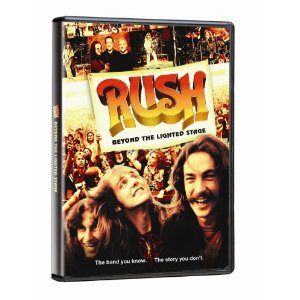 The new Rush documentary film Beyond The Lighted Stage is incredibly good. A story of immense talent, much struggle, horrific tragedy, and incredible perseverance, Rush has been chronicled here in every stage of their career. This tale of strong personalities standing up to critics and their own record company speaks to the underdog in all of us. Even if you never cared for Rush, you will have a newfound respect when the film ends, credits rolling over a scene of the three musicians having dinner at a hunting lodge. Much of the film was shot in their native Canada, giving it a more personal feel and insight.
The new Rush documentary film Beyond The Lighted Stage is incredibly good. A story of immense talent, much struggle, horrific tragedy, and incredible perseverance, Rush has been chronicled here in every stage of their career. This tale of strong personalities standing up to critics and their own record company speaks to the underdog in all of us. Even if you never cared for Rush, you will have a newfound respect when the film ends, credits rolling over a scene of the three musicians having dinner at a hunting lodge. Much of the film was shot in their native Canada, giving it a more personal feel and insight.
One major strength of this film is its insights into why fans go for this Canadian trio. For a band that has, for years, been dismissed as aloof and out of sync with current sounds, Rush has actually made a personal impact on a lot of people’s lives. Their song “Working Man” on their debut album went over big in its debut on American radio. A Cleveland radio station received, after every play, numerous requests from locals in this working class factory town who felt the song was about them. Listeners also thought it was the new Led Zeppelin album. Flash forward to the early 1980s where the film depicts how their song “Subdivisions” worked to reassure youthful misfits and dreamers that they were not alone and that they too would one day discover their own glory.
The documentary depicts how Rush’s breakthrough concept album 2112 was written and recorded during a time of struggle between Rush and their record company. While thematically focusing on an individual struggling against a futuristic dictatorship, 2112 was actually inspired by the band’s battle with their own puppeteers. Their label was putting demands on them to focus on singles after their previous concept album flopped. Instead of capitulating to corporate demands, Rush struck out with another 20 plus minutes album side story song.
“No, we’re not going to do those things. No, you can’t tell us what to do. And no, we don’t care,” drummer and lyricist Neil Peart recounted what they said to a bean counter. After 2112 album sales took off by word of mouth and Rush were playing larger venues, their record company could no longer tell them what to do, ever. From that moment on, Rush would send the label their latest recording and the label would just do their own jobs at their end. The documentary uses great footage and perfect narration to highlight this turning point in the band’s career, brought about by Rush’s own chutzpah.
The documentary details what Gene Simmons described about Rush: They’re fearless. They were never afraid to introduce their audience to heretofore unheard of odd time signatures, unexpected tempo changes, sci fi/fantasy songwriting themes. Testimony from Simmons about boldness goes a long way to convince you this trio were never wimpy. Rush was rewarded with greater albums sales and larger concert venues every time they dared to boldly go where no hard rock band had gone before.
Identifying their impact on the generation of musicians who came after them, the documentary includes testaments from Trent Raznor, Kirk Hammet, Sebastian Bach, Vinnie Paul, Billy Corgan, and Jack Black. Black attributed the band’s longevity to having a lot more “rocket sauce” than most other bands. Billy Corgan discussed how the band was overlooked by Rolling Stone Magazine’s “best of” lists and other institutions that lay out the accolades for bands. Corgan’s interview explained that the band’s success was that at the end of the day, it doesn’t matter what someone at Rolling Stone thinks. Rock and roll is a people’s game and “the people have constantly voted for this band.” The film actually achieves a strong statement when someone like Corgan has such admiration for this trio that he has spent time thinking about their music and their career.
The documentary begins as Rush readies for a recent concert. Just as they’re about to go on stage, the film shifts gears to black and white footage of a concert they did in the mid-1970s, their early days. Artful shifts like that kept tying the band’s current situation and outlook to their developing personalities in their young manhood. Lee’s parent’s survived the Holocaust and his father died when he was 12. After completing a daily synagogue duty for 11 months and a day, his mother bought him a guitar. Lifeson’s parents fled communist Yugoslavia and they had to borrow money to buy him his first guitar. Old family movies and interviews with Lee and Lifeson’s moms give a lot of insight into these men. Both of Neil Peart’s parents are interviewed about the moment when Peart had to leave his father’s farm equipment business to join the band. It comes as no surprise that these three were prepared to deal with critics and record companies.
The film gains credibility in the beginning with a good amount of footage and a quote from their first drummer John Rutsey. Rutsey’s contributions are fairly acknowledge and the band’s representative made clear that the drummer’s sugar diabetes was the only reason he left the band. The only drawbacks to Beyond The Lighted Stage is its omission of Peart’s struggles to find success in Great Britain before he returned to Canada to work for his father. The film also makes no mention of Canadian musician-songwriter Pye Dubois who co-wrote the lyrics for Rush’s two biggest songs, “Tom Sawyer” and “Closer To The Heart.” Dubois also co-wrote “Between Sun And Moon” and the title track for “Test For Echo.” You’d think that the film would explore why a respected lyricist like Peart worked with a co-writer.
Directors Scot McFayden and Sam Dunn have done a fantastic job juxtaposing film footage from the band’s long career with contemporary interviews. They also, unfortunately, were working for Rush and SRO management when they were making the film. It is not an independently made documentary. This forces you to wonder if the trio would’ve been called out on the carpet about a few things if the film was made by independent directors.
www.rush.com

